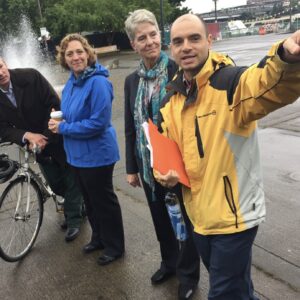“… The idea of a Barbur road diet is obviously not something all our regional partners have signed off on. We hope they will not be perturbed by the prospect of a study of a road diet…”
— Steve Novick, City of Portland Transportation Commissioner
At tomorrow’s City Council meeting, Transportation Commissioner Steve Novick had the opportunity to take a significant step toward updating the design of SW Barbur Blvd. With the Council set to endorse the regional Southwest Corridor Plan, the Bicycle Transportation Alliance (BTA) urged Novick and his colleagues to prioritize a study of two projects within that plan — both of which are referred to as the “Barbur Lane Diet” project. This prioritization was to take the form of an amendment to the SW Corridor Plan resolution that would have specifically called out the study.
However, as we reported Friday afternoon, Novick has declined this opportunity. In a statement posted to his website late yesterday, Novick wrote that he doesn’t feel adding that language to the SW Corridor Plan resolution is the “right approach”. “I would rather not link the Barbur road diet study to the Southwest Corridor resolution,” he wrote. Novick then spelled out two reasons for his decision:
Here’s the first one:
… the idea of a Barbur road diet is obviously not something all our regional partners have signed off on. We hope they will not be perturbed by the prospect of a study of a road diet, but we think that attaching this issue to the resolution could detract from what we think Wednesday’s message should be: The region is moving forward together on the Southwest Corridor Plan.
It’s important to remember that no one was being asked to “sign off” on the Barbur road diet. The amendment language would have only demonstrated the City of Portland’s commitment to moving forward on a study of the Barbur lane diet option. As for his concerns about how it would “detract” from the Plan’s overall message, that’s understandable. In fact, we pointed out last week that the BTA was taking a risk by advocating for this study within the Plan (instead of trying to make it a separate issue without the plan’s strings attached).
Here’s Novick’s second reason for not taking up the Barbur amendment:
… the idea of a Barbur road diet is something I think should be studied regardless of whether there was any such thing as a Southwest Corridor Plan focused on high capacity transit. The Southwest Corridor plan will take shape over a dozen years; I would like to do a Barbur road diet study in a dozen months.
This is the first hint of a timeline we have heard from Novick. He says he’d like to do a Barbur road diet study “in a dozen months”. That timeline isn’t likely to sit well with people who are concerned that the road is currently a public safety hazard. Portlanders have been clamoring for a safer Barbur Blvd since the 1990s and we’ve recently seen a major uptick in urgency for this project from not just the BTA, but from the the City of Portland Bicycle Advisory Committee, Friends of Barbur, the president of Lewis & Clark College, Oregon Walks, the City Club of Portland, victims of collisions on Barbur, and others.
One PBOT source said a high quality study of Barbur Blvd could be done in less than two weeks.
Also in relation to a timeline, Novick explained that the upcoming ODOT project to repair the Vermont and Newbury bridges would, “provide an excellent opportunity to see how traffic responds to reduced travel lanes during construction in real world conditions.” “The Portland Bureau of Transportation will commit the time and resources to work with ODOT and engage the surrounding communities to see the impacts of a possible road diet and find the right solution,” wrote Novick. “This data, combined with feedback from all of those traveling in the corridor, will help inform road diet deliberations.”
There are a few things to keep in mind with Novick’s plan to focus PBOT’s analysis on that bridge project. First, a major construction project where ODOT is doing extensive public outreach about the traffic impacts, is far from “real world conditions”. Also, this is an ODOT project, which means they’ll be in the driver’s seat. That’s significant because ODOT has shown for months now that they are very reluctant to the idea of bike lanes on Barbur. And finally, ODOT’s bridge repair project isn’t scheduled to being until early next year.
While Novick’s latest statements don’t reveal any significant breakthroughs for a redesign of Barbur Blvd*, last week his Chief of Staff Chris Warner shared with us that his boss remains committed to a safer Barbur. “This is a question of tactics, not values,” wrote Warner via email. Warner also said that Novick will take an active role in this issue by “following up with calls to regional partners” and by joining the SW Corridor Plan Steering Committee at its meeting later this month.
As we consider Novick’s current tone on this project, it seems very clear that ODOT Region 1 Director Jason Tell has had a major impact on his thinking. Tell wrote Novick a letter that amounted to a Barbur Blvd 101 lesson back on September 30th.
As for whether or not Novick’s statement changes the BTA’s strategy, we expect to hear more from them later today (see below for update).
(*Note: It appears there are conflicting views on Novick’s statement. Some people read his statement: “The Portland Bureau of Transportation will commit the time and resources to work with ODOT and engage the surrounding communities to see the impacts of a possible road diet and find the right solution,” as a clear indication that he intends to do a collaborative, transparent analysis of the road diet — which is precisely what the BTA and others have been asking for. I however read that statement as referring to the traffic analysis planned during ODOT’s bridge project. I’ve asked for clarification from Novick’s office but have yet to hear back. UPDATE, 12:49: We’ve heard from Novick’s office and have clarified that indeed, Novick has only committed to working with ODOT on their analysis of traffic during the bridge project. Put another way, PBOT hasn’t committed to the “transparent and collaborative process with Metro and ODOT” that the BTA and many others have been calling for.)
— In other Barbur news, The Oregonian Editorial Board has officially weighed in. Follow all of our Barbur Blvd coverage here.
UPDATE, 11:05 AM: The BTA is calling Novick’s statement a “victory for safety” and has posted more on their blog.







Thanks for reading.
BikePortland has served this community with independent community journalism since 2005. We rely on subscriptions from readers like you to survive. Your financial support is vital in keeping this valuable resource alive and well.
Please subscribe today to strengthen and expand our work.
Personally, I thought it was odd that over the last week or two, there was suddenly all this talk of tying the road diet to the SW Corridor Plan. Seems to me we want them to be two separate things.
The whole point of us getting vocal and active about this right now is so we can get a Barbur road diet done sooner than the eternity that the SWCP will take. I think Novick’s doing the right thing here.
Yay, a call for studies. That is gonna fix things and quick! So basically it is still more important to see how traffic is affected over possibly saving even one life. Getting a little tired of the hand wringing over the convenience for motorists.
Time for the SW commuters to organize a bike pool and take the lane at a leisurely pace during rush hour everyday?
So apparently, the situation on Barbur is not an “emergency” like Vista Bridge jumpers are, or else Novick would use the same powers to enact a temporary road diet in the same way he did to arbitrarily throw up ugly chain link barriers on a historic bridge. Sheesh, safety for commuters, kids and athletes is clearly just not as important as protecting despondent individuals from themselves to Novick.
From Portland Tribune reportage of the barriers: ” Under the City Code, a commissioner can declare an emergency when the public’s safety is endangered, a move that allows immediate action.”
If Novick will just sit on his hands, I call upon one of the other city commissioners to have some spine and make a temporary fix NOW, and get a permanent solution engineered ASAP. And if the city can make changes to a bridge that is on the National Register of Historic Places, they better have the power to do the same to ODOT’s on Barbur.
“So apparently, the situation on Barbur is not an “emergency” like Vista Bridge jumpers are, or else Novick would use the same powers to enact a temporary road diet in the same way he did to arbitrarily throw up ugly chain link barriers on a historic bridge. …” JasonH
Your sarcasm aside, I’d say you’re correct that the situation on Barbur is not an “emergency” like Vista Bridge jumpers are…”.
The situation on Barbur isn’t good for biking and walking. The situation there may even fairly be considered an emergency of sorts, but it’s not an emergency involving people that are willfully seeking to bring an end to their lives.
To bring about changes to Barbur’s lane configuration and traffic controls that would allow the road to be safer for walking and biking, other details and points that are consistent with that particular road and the types of people that use it, most likely would stand a better chance of winning enough people over to actually make the changes.
Presuming PBOT only counted the 5 PM traffic (assuming it was the worst hour) it might take two weeks just to collect the data to put into the model, though the model could also be built during that time.
from the Oregonian: The Oregon Department of Transportation and the city of Portland should look at this issue with the goal of achieving the best total outcome for transportation through that portion of the city.
so the O thinks that transportation should be the best possible outcome rather than safety…
typical Oregon Editorial Board drivel…
That statement from the O is meaningless.
Reading about Barbur nauseates me. It is a prolonged battle of bureaucrates. A study will take two years. Expect a proposal, subject to public comment, in 2023 or so.
I cannot believe the BTA calls this a victory. The biggest bike org in the state accepts crumbs from city council and declares it to be enough. Please don’t send a thank you e-mail to our commissioners like BTA has asked you to, or else they’ll start thinking those crumbs are enough.